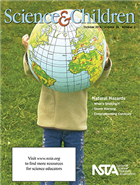Weather watching
By Peggy Ashbrook
Posted on 2016-10-06

This visible image on Oct. 6 at 1:00 p.m. EDT from NOAA’s GOES-East satellite shows Hurricane Matthew as it regained Category 4 Hurricane Status.
Credits: NASA/NOAA GOES Project
As Hurricane Matthew traveled across the Caribbean and into the Atlantic, I think of how children who live in its path and those at a distance will make sense of the force of this extreme weather event. Science education can sometimes mean talking about scary or tragic events. Be sensitive to fears and stress by asking families about children’s previous experiences with natural disasters such as the flooding in Louisiana and West Virginia this past summer.
Even with relatively minor flooding events, children have questions such as, “What happens when water goes or stays where we don’t want it?” When localized flooding due to a plugged county drain affected just their building, children in the Frog Pond Early Learning Center in Fairfax County, Virginia, wanted to understand the process and talk about how to prevent it. Gail Dickert, Executive Director of the non-profit, said that the flooding led to stronger relationships with and between families. For the five weeks of cleanup after the county line backed up and poured sewage into their building, the school helped some families make other arrangements and created a combined age classroom for children 18 months to 5 years old for others. The children missed being with their usual friends but were curious about “how and why.” They were interested in finding solutions because they were displaced from their usual routines.
Resources for adults to help young children cope with violence and tragedies include The Fred Rogers Company article about tragic events. Mr. Rogers said, “In times of crisis, children want to know, ‘Who will take care of me?’…They also need to hear that people in the government and other grownups they don’t even know are working hard to keep them safe, too.” “Other grownups” includes teachers!
 Resources for understanding weather events of all kinds includes the October issue of Science and Children with “Storm Warning,” a free feature article by Tammy Lee, Meredith Kier, and Kelsey Phillips, and these additional resources:
Resources for understanding weather events of all kinds includes the October issue of Science and Children with “Storm Warning,” a free feature article by Tammy Lee, Meredith Kier, and Kelsey Phillips, and these additional resources:
“Science Shorts: Weather Watchers,” in the April 2011 Science and Children by Sami Kahn.
The CoCoRaHS School Pilot Program for collecting data, a project of the Community Collaborative Rain, Hail and Snow Network.
Hurricanes! by Gail Gibbons. 2009. Holiday House.
Hurricanes by Seymore Simon. 2007. HarperCollins.
Ready, Set…WAIT! by Patti R. Zelch, Illustrated by Connie McLennan. 2009. Arbordale.
Disclaimer: The views expressed in this blog post are those of the author(s) and do not necessarily reflect the official position of the National Science Teaching Association (NSTA).


